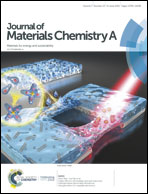Engineering the underlying surface to manipulate the growth of 2D perovskites for highly efficient solar cells†
Abstract
Two-dimensional (2D) perovskites are promising candidates for perovskite solar cells (PVSCs) due to their superior stability compared to their three-dimensional counterparts. While the effects of processing conditions, e.g. the choice of solvent, temperature and additives have been widely studied, fewer studies have been carried out to investigate the influence of underlying substrates on the growth of 2D perovskites. In this work, a thin poly[(9,9-bis(3′-(N,N-dimethylamino)propyl)-2,7-fluorene)-alt-2,7-(9,9-dioctylfluorene)] (PFN) interface layer is applied on top of the hole transporting poly[bis(4-phenyl)(2,4,6-trimethylphenyl)amine] (PTAA) layer to modulate the formation of 2D perovskite films with a nominal composition of PEA2MA3.5FA0.5Pb5I16 calculated from precursors. 2D perovskite films grown on the PFN layer have better surface coverage and reproducibility due to the improved surface wettability. We also discovered that the PFN layer reduces the formation of the n = 1 phase in the 2D perovskite films, resulting in an enhanced light absorption. Besides, the insertion of PFN reduces trap-assisted recombination, without affecting the charge extraction. The optimized planar-structured PVSCs with PFN exhibit the best PCE of 12.78%, which is a 24.3% enhancement compared to that of the devices without PFN. This work provides a new insight on improving the performance of 2D PVSCs by modifying the interface between the perovskite layer and hole transport layer in a p–i–n inverted planar structure.



 Please wait while we load your content...
Please wait while we load your content...